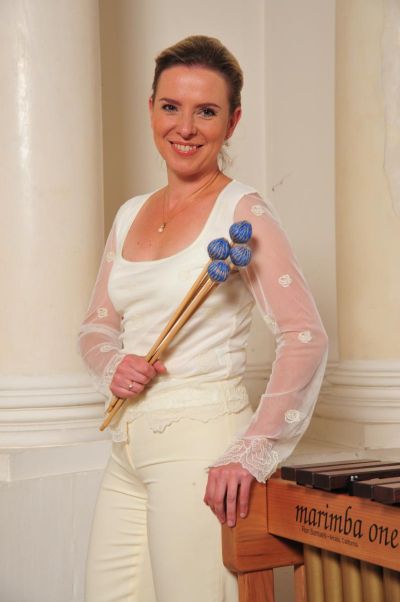Katarzyna Myćka

The marimba, as played by Katarzyna Myćka, has only existed as a solo and concert instrument since the mid-1980s. At the same time the marimbaphone is one of the oldest instruments known to mankind. Predecessors of the instrument were already known in Vietnam and Indonesia 5000 years ago. The instrument is then supposed to have arrived in Africa, where its presence was documented in writings in the Kingdom of Mali in the 14th century. What makes it different from the xylophone is its gourd-shaped (or tube-like) resonators mounted beneath wooden sound bars. The marimba came to South America with the slave trade and here it is still traditionally played in a huge number of countries. Its modern form as a chromatic two-row instrument with sound bars arranged as on a piano, was developed around 1880 in Guatemala and Mexico. The first concerts with the instrument were given in the 1930s. In 1947 Darius Milhaud wrote a concerto for Marimbaphone, Vibraphone and Orchestra. At the start of the 80s Ron Samuels began developing the Marimba One with five octaves in Arcata, California. The instrument has continued to be made by hand and is played all over the world by marimba soloists like Katarzyna Myćka.
Katarzyna Myćka was born in 1972 in Leningrad (now St. Petersburg) and grew up in Danzig/Gdańsk. At the age of sixteen, whilst she was at the music school in Danzig she changed from the piano to the drums. Two years later she began her studies at the Danzig College of Music, where she first came into contact with the marimba. In 1992, despite being the youngest participant in the Concours des Genève (CIEM), she was awarded a grant to study abroad, following which she continued her studies in 1993 in Stuttgart and at the Mozarteum in Salzburg under the drummer Peter Sadlo. Around this time she discovered the Marimba One, and was fascinated not only by the sound of the instrument but also by its lovingly handmade construction and design. She recognised the virtuoso quality of the instrument and chose it as her “ideal medium for musical expression”. In 1995 she won the first prize and audience prize for marimba solo at the International Percussion Competition in Luxemburg; and in the following year she was declared the victor at the First World Marimba Competition in Stuttgart. Myćka then ended her studies in Danzig, and her soloist class in Stuttgart. There followed further grants and invitations to master classes in the USA, Asia and several different European countries. These helped the young musician to build up a network of contacts very quickly. Today specialists and critics alike bear witness to the extraordinary richness of her tone quality, her “fascinatingly broad palette of musical effects” and, given the way she handles the dancing swirling mallets, her “supreme fluidity”, “perfect mallet technique” and a “dreamlike rhythmic precision”.
Because the modern marimba only goes back around thirty years compositions are limited. Adaptations of classical compositions like Mussorgsky’s “Pictures from an Exhibition”, pieces by Bach, Vivaldi and Ravel are all popular with music promoters and audiences alike. Bach’s cello suites are particularly appreciated by Myćka. She is increasingly working with young composers, with the result that around ten quality contemporary concertos for marimba have now been created within the space of a few years. Because of the sound created by the mallets the instrument is part of the drum family. That said, Myćka considers that the instrument is nearer the piano because of its melodic qualities. But since its upper tones do not sound good in every pitch in all intervals, the marimba presents great challenges to both adapters and composers.
Myćka’s solo repertoire includes Bach’s Cello Suites 2 and 3, the Toccata and Fuge in D minor, Chopin’s “Revolutions Étude“ and Prokofiev’s “Romeo and Juliet”, alongside contemporary compositions by the Japanese marimba virtuoso and composer, Abe Keiko, and pieces by Jacob Druckman, David Friedman, Arkadiusz Kątny, Igmar Alderete Acosta and Emmanuel Séjourné. Furthermore her orchestral repertoire includes cembalo and violin concertos by Bach, pieces for marimba duets, including tangos by Astor Piazzolla, as well as works for the marimba with drum ensembles, the organ and choirs written by contemporary composers. One of her particularly memorable performances was the Concerto for Marimba, Trumpet and String Orchestra in two movements by Anna Ignatowicz-Glińska (born 1968 in Warsaw), with the Prague Chamber Philharmonic Orchestra conducted by Matthias Kuhn, which had its German premiere in the Stuttgart Liederhalle.





